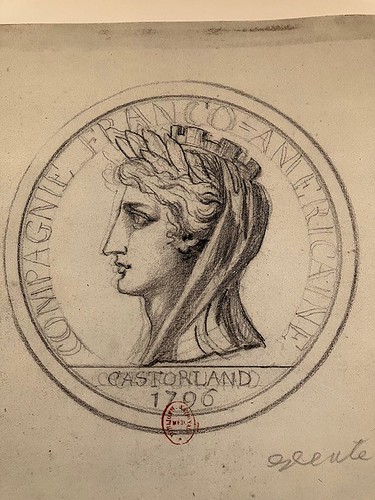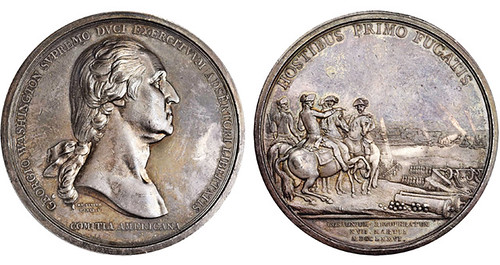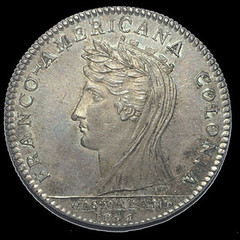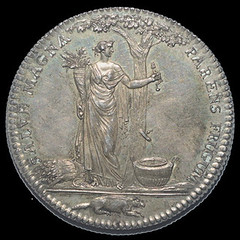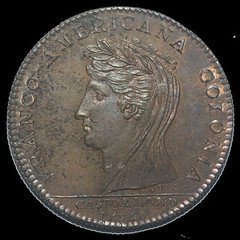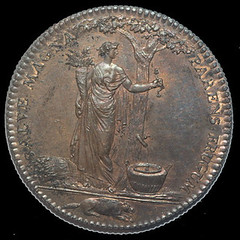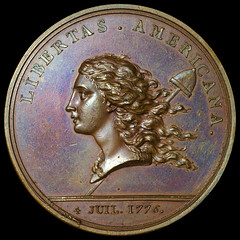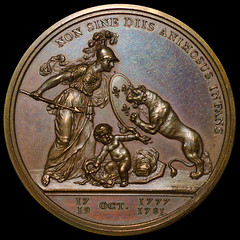
PREV ARTICLE
NEXT ARTICLE
FULL ISSUE
PREV FULL ISSUE
V25 2022 INDEX E-SYLUM ARCHIVE DUVIVIER PUZZLER ANSWERSLast week Chester Sullivan asked:
Pete Jones writes: "Thank you Chester Sullivan for your puzzle! The lady depicted on Duvivier's drawing for the Castorland jeton is presumably Marianne — the French goddess of liberty who started during the French Revolution (1789-1799). Marianne was the French equivalent of the American allegory of Liberty derived from France's Augustin Dupré's 1781 Libertas American medal. "Thank you Chester Sullivan for your puzzle! However, there is an anomaly on the Castorland jeton: Marianne's attributes should be a Phrygian cap or cockaded hat, not a mural crown, which was for city deities or Tyche (Fortuna in Rome)." David Gladfelter writes: "Let me comment on Chester's third question (Chester has been working diligently for several years on a historical and die variety study of Castorland medals; his observations about the portrait on the medals will be of interest to us all):
"The drawing on which the medal design is based has a signature that appears to read
"It is not an "So perhaps these comments are off base. Let's see what answers Chester was looking for." Here's a lengthier response from Roger Siboni. -Editor
The puzzler image is not
The image presented represents Cybele, the Roman Great Mother of the Gods personifying Interestingly the reverse of the Jeton ultimately produced from this rendering (see below) features Ceres tapping into a sap flowing maple tree holding a cornucopia of abundant grain flower and foliage. Ceres is the Roman goddess of agriculture, grain, crops, fertility and motherly relationships.
The obverse legend in Latin reads French American Colony. The reverse legend borrows from Virgil
The more complete story here is quite interesting. Duvivier was a royalist and of the wealthy class living at the time under the reign of terror of the French Revolution. It is speculated that his affiliation with the royalist class was the reason he lost his position of Chief Engraver at the Paris Mint and replaced by his apprentice The Compaignie de New York (the Castorland Company) was formed as a refuge for the ruling class to escape France and come to an Oasis of freedom and plenty in North America. Duvivier was a founding subscriber to the Castorland project and agreed to make Jetons privately.
According to Title V article 9 of the Compaignie de New York's Constitution (bylaws), each of the Commissioners (or Board of Directors) was to receive two silver Jetons per meeting attended. Sadly, despite remarkable efforts getting to and settling in to what turned out to be near uninhabitable forest and swamp land in upstate New York, the project ended in total failure and the Castorland Company was ultimately liquidated in 1814 in conjunction with the end of its charter. Very few of the many subscribers, including Duvivier, to Castorland acreage never stepped foot in the project or even North America. A few more interesting numismatic tidbits are that this story would largely be unknown were it not for William Sumner Appleton discovering the original Castorland journal in France in a used book store in Paris while touring Europe upon completion of graduating from Harvard. He later donated the Journal to the Massachusetts Historical Society where later researcher Dr Franklin B Hough transcribed it and made it part of his History of Lewis and Jefferson Counties New York. That made this story available to us.
The final interesting tidbit (to me) about the artisanship of this Jeton is its
While still debatable and being researched. Early die states of the Castorland Jeton exhibiting no die spalling near the reverse maple vessel or breaks in the legend are considered very rare Here's Chester Sullivan's response. -Editor This little puzzler did stir the pot and produce lots of interesting comments. I'm grateful. The answers are: 1. Cybele, the Mother of the gods. She's well known in Europe, and the Fountain of Cybele is an unmistakable Madrid landmark. Triumphant, she's carved in stone driving her chariot—pulled by two male lions. The myth of Cybele seems to have originated somewhere in the north of present-day Turkey. Her Roman cult competed with early Christians, there were Roman temples dedicated to her, and she's one of the false gods despised by early Christians. Practitioners of Cybele's cult paraded the streets of Rome blowing horns, beating drums, and exhibiting, shall we say, obscene behavior. Her image appears on many Roman coins. 2. Cybele is significant to American numismatics because Benjamin Duvivier chose her as a portrait figure for America's Most Beautiful French Coin. Prior to the French Revolution Benjamin Duvivier (and Jean Duvivier, his father) used the kings of France on medals, jetons, and specie money. But Benjamin Duvivier obviously couldn't use the portrait of a French king for this jeton, so he chose Cybele as a substitute. These first two questions aren't too hard. But the third one was tricky. 3. The sketch drawing is easily recognized by collectors of American coins, especially those who specialize in Colonial coins. It shows Cybele (as she appears on America's Most Beautiful Coin) facing left, adorned with her mural crown, laurel wreath, and scarf. The key date,1796, appears beneath the exergue line, as it does on the coin. No anomaly yet, but now look closely—the legend of the coin is FRANCO-AMERICANA COLONIA, French-American Colony. But the legend in the drawing is COMPAGNIE FRANCO-AMERICAINE, Company French American. The name of the company responsible for making these jetons was, The New York Company (in reference to western New York State, where the Castorland land tract was located). Therefore, this drawing proves Pierre Chassanis, director of the company, vacillated between the two words and chose company. This, and much other documentary evidence, disproves the longstanding and erroneous myth that Castorland was the tragically failed attempt of desperate Frenchmen fleeing the bloody French Revolution to form a colony and a new life for themselves in America. A full reading of the Castorland documentation (some of it, like the drawing, recently discovered in Paris) shows Pierre Chassanis' company to have been not a tragically failed colony but a well-planned and highly successful land development (exploitation) company involving French investors, Swiss bankers, and American politicians. Thanks, everyone. -Editor
To read the earlier E-Sylum article, see:
Wayne Homren, Editor The Numismatic Bibliomania Society is a non-profit organization promoting numismatic literature. See our web site at coinbooks.org. To submit items for publication in The E-Sylum, write to the Editor at this address: whomren@gmail.com To subscribe go to: https://my.binhost.com/lists/listinfo/esylum All Rights Reserved. NBS Home Page Contact the NBS webmaster 
|
